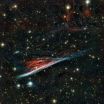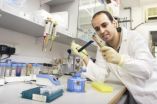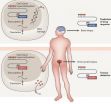(Press-News.org) The Pencil Nebula is pictured in a new image from ESO's La Silla Observatory in Chile. This peculiar cloud of glowing gas is part of a huge ring of wreckage left over after a supernova explosion that took place about 11 000 years ago. This detailed view was produced by the Wide Field Imager on the MPG/ESO 2.2-metre telescope.
Despite the tranquil and apparently unchanging beauty of a starry night, the Universe is far from being a quiet place. Stars are being born and dying in an endless cycle, and sometimes the death of a star can create a vista of unequalled beauty as material is blasted out into space to form strange structures in the sky.
This new image from the Wide Field Imager on the MPG/ESO 2.2-metre telescope at ESO's La Silla Observatory in Chile shows the Pencil Nebula [1] against a rich starry background. This oddly shaped cloud, which is also known as NGC 2736, is a small part of a supernova remnant [2] in the southern constellation of Vela (The Sails). These glowing filaments were created by the violent death of a star that took place about 11 000 years ago. The brightest part resembles a pencil; hence the name, but the whole structure looks rather more like a traditional witch's broom.
The Vela supernova remnant is an expanding shell of gas that originated from the supernova explosion. Initially the shock wave was moving at millions of kilometres per hour, but as it expanded through space it ploughed through the gas between the stars, which has slowed it considerably and created strangely shaped folds of nebulosity. The Pencil Nebula is the brightest part of this huge shell.
This new image shows large, wispy filamentary structures, smaller bright knots of gas and patches of diffuse gas. The nebula's luminous appearance comes from dense gas regions that have been struck by the supernova shock wave. As the shock wave travels through space, it rams into the interstellar material. At first, the gas was heated to millions of degrees, but it then subsequently cooled down and is still giving off the faint glow that was captured in the new image.
By looking at the different colours of the nebula, astronomers have been able to map the temperature of the gas. Some regions are still so hot that the emission is dominated by ionised oxygen atoms, which glow blue in the picture. Other cooler regions are seen glowing red, due to emission from hydrogen.
The Pencil Nebula measures about 0.75 light-years across and is moving through the interstellar medium at about 650 000 kilometres per hour. Remarkably, even at its distance of approximately 800 light-years from Earth, this means that it will noticeably change its position relative to the background stars within a human lifetime. Even after 11 000 years the supernova explosion is still changing the face of the night sky.
INFORMATION:
Notes
[1] The Pencil Nebula, also known as NGC 2736 and sometimes nicknamed Herschel's Ray, was discovered by British astronomer John Herschel back in 1835 while he was in South Africa. He described it as "an extraordinary long narrow ray of excessively feeble light".
[2] A supernova is a violent stellar explosion, resulting from the death of either a high-mass star or a white dwarf in a close double star system. The structure resulting from the explosion is called the supernova remnant. This consists of ejected material expanding at supersonic velocities into the surrounding interstellar medium. Supernovae are the main source of the heavier chemical elements in the interstellar medium, which in turn leads to the chemical enrichment of a new generation of stars and planets.
More information
The year 2012 marks the 50th anniversary of the founding of the European Southern Observatory (ESO). ESO is the foremost intergovernmental astronomy organisation in Europe and the world's most productive ground-based astronomical observatory by far. It is supported by 15 countries: Austria, Belgium, Brazil, the Czech Republic, Denmark, France, Finland, Germany, Italy, the Netherlands, Portugal, Spain, Sweden, Switzerland and the United Kingdom. ESO carries out an ambitious programme focused on the design, construction and operation of powerful ground-based observing facilities enabling astronomers to make important scientific discoveries. ESO also plays a leading role in promoting and organising cooperation in astronomical research. ESO operates three unique world-class observing sites in Chile: La Silla, Paranal and Chajnantor. At Paranal, ESO operates the Very Large Telescope, the world's most advanced visible-light astronomical observatory and two survey telescopes. VISTA works in the infrared and is the world's largest survey telescope and the VLT Survey Telescope is the largest telescope designed to exclusively survey the skies in visible light. ESO is the European partner of a revolutionary astronomical telescope ALMA, the largest astronomical project in existence. ESO is currently planning the 39-metre European Extremely Large optical/near-infrared Telescope, the E-ELT, which will become "the world's biggest eye on the sky".
Links
[Photos of the MPG/ESO 2.2-metre telescope][1]
[Other photos taken with the MPG/ESO 2.2-metre telescope][2]
[Photos of La Silla][3]
[1]: http://www.eso.org/public/images/archive/search/?adv=&subject_name=mpg
[2]: http://www.eso.org/public/images/archive/search/?adv=&facility=15
[3]: http://www.eso.org/public/images/archive/category/lasilla/
Contacts
Richard Hook
ESO, La Silla, Paranal, E-ELT & Survey Telescopes Press Officer
Garching bei München, Germany
Tel: +49 89 3200 6655
Cell: +49 151 1537 3591
Email: rhook@eso.org
A celestial witch's broom?
A new view of the pencil Nebula
2012-09-12
ELSE PRESS RELEASES FROM THIS DATE:
Studies shed light on how to reduce the amount of toxins in plant-derived foods
2012-09-12
A number of environmental toxins pose considerable health threats to humans, and the heavy metal cadmium (Cd) ranks high on the list. Most of us are exposed to it through plant-derived foods such as grains and vegetables. Now, new research offers ways in which investigators can reduce the amount of Cd found in the food we eat, according to a review published online September 12th in the Cell Press journal Trends in Plant Science.
"Cadmium is virtually everywhere in the environment, and it is taken up into the human body and bioaccumulates for decades in the kidney," ...
Gut bacteria increase fat absorption
2012-09-12
Baltimore, MD —You may think you have dinner all to yourself, but you're actually sharing it with a vast community of microbes waiting within your digestive tract. A new study from a team including Carnegie's Steve Farber and Juliana Carten reveals that some gut microbes increase the absorption of dietary fats, allowing the host organism to extract more calories from the same amount of food.
Previous studies showed gut microbes aid in the breakdown of complex carbohydrates, but their role in dietary fat metabolism remained a mystery, until now. The research is published ...
Sandia, OurEnergyPolicy.org release 'Goals of Energy Policy' poll results
2012-09-12
LIVERMORE, Calif.— U.S. energy policy should simultaneously pursue security of its energy supply, economic stability and reduced environmental impacts, says a national poll of energy professionals jointly prepared by Sandia National Laboratories and OurEnergyPolicy.org.
The findings of the national poll, "The Goals of Energy Policy," show that the vast majority — more than 85 percent — of the 884 energy professionals surveyed prefer policymaking that pursues all three goals at once.
The poll asked the experts to allocate 100 points, representing a 100 percent policymaking ...
New paper addresses causes of shattering glass cookware; Margin of safety described as 'borderline'
2012-09-12
A new paper appearing in the September 2012 edition of the Bulletin of The American Ceramic Society for the first time provides a scientific explanation of why some glass cookware sold in the United States is more susceptible than others to "explosive" shattering and the possibility of exposing consumers to injury from flying glass shards.
Clear glass baking dishes and pots are a staple in many households around the world and have been since they were first introduced in 1915 to consumers by the Corning Glass Works, which created the Pyrex brand name. The original Pyrex ...
Old deeds, witness trees offer glimpse of pre-settlement forest in West Virginia
2012-09-12
PARSONS, W. Va., September 12, 2012 – Using old deeds and witness trees, a U.S. Forest Service scientist has created a glimpse of the composition of the forests that covered today's Monongahela National Forest before settlement and logging changed the landscape.
"European Settlement-Era Vegetation of the Monongahela National Forest, West Virginia" describes how a Forest Service scientist and her West Virginia University colleague answered questions about the composition of early forests using a unique dataset. The dataset was built with original deeds, metes and bounds ...
Predicting a die throw
2012-09-12
Vegas, Monte Carlo, and Atlantic City draw people from around the world who are willing to throw the dice and take their chances. Researchers from the Technical University of Lodz, Poland, have spotted something predictable in the seemingly random throw of the dice. By applying chaos theory and some high school level mechanics, they determined that by knowing the initial conditions – such as the viscosity of the air, the acceleration of gravity, and the friction of the table – it should be possible to predict the outcome when rolling the dice.
The researchers created ...
A carefully scheduled high-fat diet resets metabolism and prevents obesity
2012-09-12
New research from the Hebrew University of Jerusalem shows that a carefully scheduled high-fat diet can lead to a reduction in body weight and a unique metabolism in which ingested fats are not stored, but rather used for energy at times when no food is available.
The research was conducted by Prof. Oren Froy along with Prof. Zecharia Madar, research student Yoni Genzer and research fellow Dr. Hadas Sherman at the Institute of Biochemistry, Food Science and Nutrition, at the Hebrew University's Robert H. Smith Faculty of Agriculture, Food and Environment. The results ...
Epigenetics emerges powerfully as a clinical tool
2012-09-12
The research team led by Manel Esteller, director of the Cancer Epigenetics and Biology Program at the Bellvitge Biomedical Research Institute (IDIBELL), professor of genetics at the University of Barcelona and ICREA researcher, has updated the latest findings in applied epigenetics in a review paper published in Nature Reviews Genetics.
There is a growing need for better biomarkers that allow early detection of human diseases, especially cancer. The markers can improve primary prevention, diagnosis and prognosis of disease. Furthermore, it is possible to predict which ...
First pediatric study to look at the role of vitamin D in critical illness
2012-09-12
OTTAWA, Canada, September 12, 2012—Vitamin D is increasingly being recognized as important for good health. Vitamin D is a hormone made in the skin following sun exposure or acquired from diet and supplement intake. Previous medical research has shown that low body levels of vitamin D make people more susceptible to problems such as bone fractures, poor mental health and infections like the common cold. Until recently, there had been little consideration given to the role of vitamin D in more severe diseases, which is why Dr. Dayre McNally's recent publication in the esteemed ...
Study implicates marijuana use in pregnancy problems
2012-09-12
CINCINNATI – New research indicates marijuana-like compounds called endocannabinoids alter genes and biological signals critical to the formation of a normal placenta during pregnancy and may contribute to pregnancy complications like preeclampsia.
A study in the Sept. 14 edition of The Journal of Biological Chemistry offers new evidence that abnormal biological signaling by endocannabinoid lipid molecules produced by the body disrupts the movement of early embryonic cells important to a healthy pregnancy, in particular trophoblast cells that form the placenta. Abnormal ...
LAST 30 PRESS RELEASES:
Making lighter work of calculating fluid and heat flow
Normalizing blood sugar can halve heart attack risk
Lowering blood sugar cuts heart attack risk in people with prediabetes
Study links genetic variants to risk of blinding eye disease in premature infants
Non-opioid ‘pain sponge’ therapy halts cartilage degeneration and relieves chronic pain
AI can pick up cultural values by mimicking how kids learn
China’s ecological redlines offer fast track to 30 x 30 global conservation goal
Invisible indoor threats: emerging household contaminants and their growing risks to human health
Adding antibody treatment to chemo boosts outcomes for children with rare cancer
Germline pathogenic variants among women without a history of breast cancer
Tanning beds triple melanoma risk, potentially causing broad DNA damage
Unique bond identified as key to viral infection speed
Indoor tanning makes youthful skin much older on a genetic level
Mouse model sheds new light on the causes and potential solutions to human GI problems linked to muscular dystrophy
The Journal of Nuclear Medicine ahead-of-print tip sheet: December 12, 2025
Smarter tools for peering into the microscopic world
Applications open for funding to conduct research in the Kinsey Institute archives
Global measure underestimates the severity of food insecurity
Child survivors of critical illness are missing out on timely follow up care
Risk-based vs annual breast cancer screening / the WISDOM randomized clinical trial
University of Toronto launches Electric Vehicle Innovation Ontario to accelerate advanced EV technologies and build Canada’s innovation advantage
Early relapse predicts poor outcomes in aggressive blood cancer
American College of Lifestyle Medicine applauds two CMS models aligned with lifestyle medicine practice and reimbursement
Clinical trial finds cannabis use not a barrier to quitting nicotine vaping
Supplemental nutrition assistance program policies and food insecurity
Switching immune cells to “night mode” could limit damage after a heart attack, study suggests
URI-based Global RIghts Project report spotlights continued troubling trends in worldwide inhumane treatment
Neutrophils are less aggressive at night, explaining why nighttime heart attacks cause less damage than daytime events
Menopausal hormone therapy may not pose breast cancer risk for women with BRCA mutations
Mobile health tool may improve quality of life for adolescent and young adult breast cancer survivors
[Press-News.org] A celestial witch's broom?A new view of the pencil Nebula



